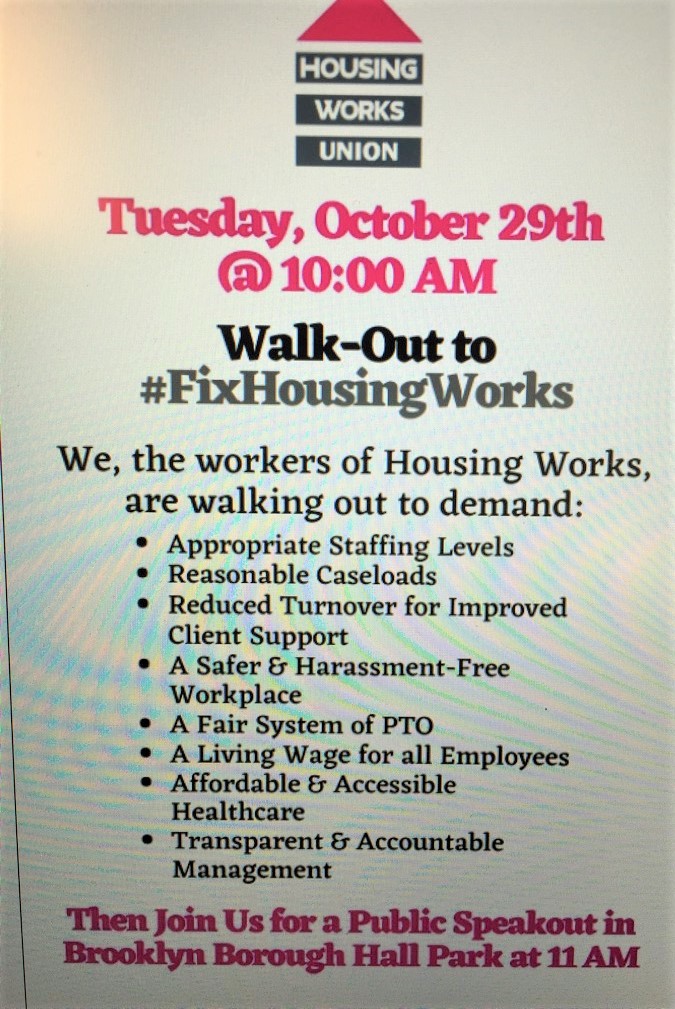
Over 100 workers from the nonprofit Housing Works walked off their jobs Oct. 29 in New York City to protest the company’s anti-union, corporate culture and working conditions.
Rallying at Brooklyn’s Borough Hall, workers from 35 Housing Works locations united to protest their low pay scales and long hours. The protest included workers from Housing Works thrift stores and bookshops in Queens, Manhattan and Brooklyn.
Stuart Appelbaum, president of the Retail, Wholesale and Department Store Union, the union organizing Housing Works, explained that a major issue was the nonprofit’s refusal to sign an agreement that would bar it from interfering in union organizing. The union plans to file unfair labor practice charges against Housing Works, claiming it intimidated workers before the walkout.
An advocacy organization defining its mission as ending “the dual crises of homelessness and AIDS through relentless advocacy,” Housing Works came out of the movement of the 1980s to demand health care and services to AIDS patients, who were subject to the most horrible discrimination. It has a long history of offering services to those in need, including housing, healthcare, meals and nutritional counseling, mental health and substance abuse treatment, job training, and legal assistance, particularly to HIV patients. It also runs thrift stores and book shops to raise money for its projects.
These many services require skilled and dedicated staff, with the patience and will to help meet the needs of people from all walks of life. However, it is clear that Housing Works has forgotten the workers who make it all happen.
Low pay and unmanageable case loads, as well as discrimination and harassment were among the many issues raised. One caseworker explained that for months he was the only housing coordinator for almost 3,000 cases. A union demand for smaller caseloads is a demand for giving better service to its clients.
Maintenance and retail workers, case managers and attorneys unite in solidarity
Ilana Engelberg, one of the union organizers, explained that “the most important thing about the walkout is that so many different types of workers were represented, from maintenance workers to attorneys, retail workers and case managers. Not only have we united across different sites, but we have united across our many different roles.”

This took careful work. In advance of the walkout, the workers circulated a leaflet listing all the issues important to them. The demands listed are testament to the advance organizing work done to insure unity and confidence in the walkout. The leaflet calls for: Appropriate staffing levels, reasonable case loads, reduced turnover for improved client support, a safer and harassment-free workplace, a fair system of paid time off, a living wage for all employees, affordable and accessible health care, transparent and accountable management.
Union-busting group hired to intimidate workers
Although Housing Works has long supported unions in New York, when it hits close to home it is a very different story. Not only has Housing Works refused to sign an agreement that would prevent it from interfering in union organizing, it has also hired the notoriously anti-union consulting firm Seyfarth & Shaw to do its dirty work for them to prevent unionization.
This outfit, which does not sell its services cheaply, brags that it is “dedicated to representing employers and championing the interests of management in their relationship with organized labor,” and “we have extensive experience in representing employers in strikes, lockouts, picketing and other labor disputes.”
This resulted in management taking a “poll” of who exactly was going to participate in the walkout, even though the union had given 10 days notice of what was being planned. This poll was meant to intimidate the staff.
Workers maintain unity
According to Engelberg, the company’s tactic was not successful.“The day of the walkout was extremely high energy. A group of case managers went together to the medical floor to show strength and let workers who were afraid that there were a lot of us ready to walk out. Previously, medical workers had been harassed and intimidated by management.”
It is the dedication, patience and perseverance of the union organizers that enabled the walkout to be so successful, since the first tactic of management in any union struggle is to divide the workers in any and every way possible. It is one important step towards building a union.
Non-profits have long used the dedication of their staff workers others against them. Management of non-profits are notoriously generous with the salaries of top management, but when it comes to the people who actually do most of the work, they so often pit the needs of their clients against the pay and working conditions of their own working staff. But the truth is what’s good for the staff is good for the client. For example, a demand for lower case loads is a demand to be able to give appropriate time and attention to clients, not an attempt by staff to work less, as management claims.
This struggle has many lessons for workplace organizing and can inspire others to do the same.





